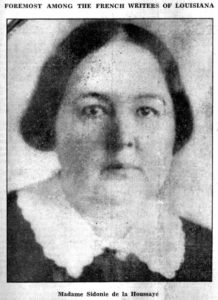Sidonie de la Houssaye
Sidonie de la Houssaye wrote about nineteenth-century Creole society.

Courtesy of Kimberly King.
A black and white reprodution of a photograph of Sidonie de la Houssaye.
Author of short stories and novels, Sidonie de La Houssaye was the only widely published woman among nineteenth-century Louisiana authors who wrote in French. In the 1880s and 1890s, she published three novels—Pouponne et Balthazar, Charles et Ella, and Amis et fortune—under her own name. In addition, she published a series of four novel, Les Quarteronnes de la Nouvelle-Orléans, under the pseudonym Louise Raymond. While some of de La Houssaye’s work has been translated into English, many of her stories have never been published. In addition to her work as a writer, de La Houssaye founded a school in Franklin, in St. Mary Parish.
Early Life
On August 17, 1820, Sidonie de La Houssaye was born Hélène Perret, the child of Ursin Perret and Francoise Pain. Born into a family of sugar planters of French descent, de La Houssaye spent her early years on Bellevue Plantation in St. John the Baptist Parish. She took the name Sidonie at an unknown point during her early childhood. By 1831, her family moved to St. Mary Parish on Louisiana’s Gulf Coast. In 1833 she briefly attended a convent school in St. James Parish, but she appears to have been largely self-taught. Around the age of thirteen, Sidonie met and married her future husband, Louis Pelletier Delahoussaye, who was twice her age and preferred a different spelling of their last name. Though the couple had six children, only four—three sons and a daughter—survived to adulthood, and only one survived Sidonie de La Houssaye.
In 1849, financial difficulties led de La Houssaye to open the Young Ladies Academy in Franklin. During the Civil War, the de La Houssayes continued to struggle financially and were eventually forced to sell the family home. The school closed in 1862, a casualty of the Civil War. De La Houssaye faced two additional tragedies in the mid-nineteenth century. In 1863, Louis Pelletier de La Houssaye died, leaving his wife in debt and with limited means of support. Then, in 1875, the de La Houssayes’ daughter Lilia died, leaving eight children that Sidonie was determined to raise.
Writing Career
Attempting to meet her family’s financial needs, de La Houssaye reopened her school after the Civil War and served as Franklin’s postmistress. She also launched a writing career in the 1870s, hoping to supplement her income. She wrote for French-language newspapers, including Le Meschacébé and Le Franc-Louisianais. At the age of sixty-three, she published her first novel Pouponne et Balthazar, as a serial story in the newspaper L’Abeille de la Nouvelle-Orléans. The novels Charles et Ella and Amis et fortune eventually followed.
A diary written by de La Houssaye’s grandmother provided material for George Washington Cable, who bought the rights to it and, with de La Houssaye’s permission, included some of its content in his 1889 book Strange True Stories of Louisiana. Cable was also instrumental is helping de La Houssaye publish her work, and the two corresponded frequently.
In addition to the works de La Houssaye published under her own name, she wrote Les Quarteronnes de la Nouvelle-Orléans, a series of four novels, under the pseudonym Louise Raymond. Apparently she used a pseudonym because of the controversial nature of her subject matter: plaçage, a system of concubinage in which wealthy white men took mulatto women as mistresses. One book in this series, Octavia, was published in 1894, the year of de La Houssaye’s death; the other three were published posthumously.
Recently her work has been republished, including a series of short stories titled Contes d’une grand-mère louisianaise. De La Houssaye’s writing is comparable in theme and style to her French contemporaries, including Honoré de Balzac and Emile Zola, insofar as she describes society and its peculiar personalities. Her Quarteronnes series contains elements of exoticism not unlike those found in much local color fiction, popular in the late nineteenth century. She also deals with themes described by her Louisiana contemporaries Cable and Alfred Mercier, including race and class relations in nineteenth-century Louisiana Creole society.
In 1890 the Athenée Louisianais, a society founded to preserve French language in Louisiana, awarded Sidonie de La Houssaye its gold medal. She died four years later on February 18, 1894. Her papers are currently in the Louisiana and Lower Mississippi Valley Collections of Louisiana State University Libraries, Baton Rouge.
